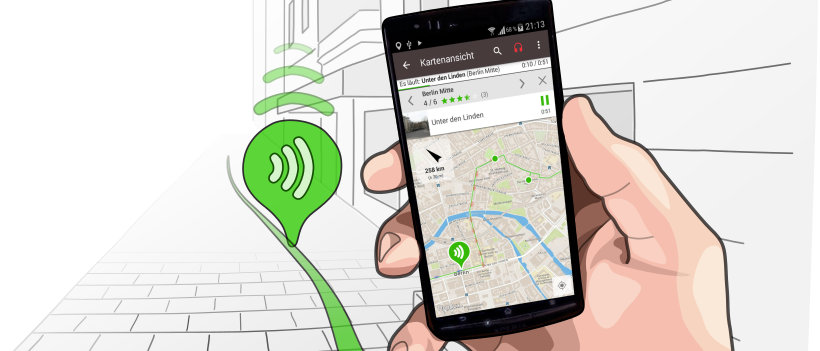Transkript Deutsch:
Gehe während der folgenden Audiospur weiter geradeaus, am Loebegge vorbei in Richtung kleine Schanze. Das ist dort, wo du Bäume sehen kannst.
Biege davor, bei der grossen Autostrasse mit Zebrastreifen, links in die Bundesgasse ab in Richtung Bundeshaus.
Seobhan: Ich habe manchmal Angst verrückt zu werden, wenn ich jemanden verliere, der mir wichtig ist und nahesteht, ich habe Angst, dass die Trauer zu tief geht und dass es mir zu viel wird, das alles zu verarbeiten.
Annette: Ein Trauerprozess läuft in Wellen. Das verläuft wellenförmig. Früher hat man von Phasen geredet, heute redet man vielmehr von Wellenbewegungen; es gibt Tiefe Momente, und es gibt es manchmal dass es ein bisschen hoch geht, einfacher wird und dann gibt es am Anfang vom Trauerprozess auch furchtbare Löcher. Es geht eigentlich darum, dass ich davon ausgehe, dass ein Trauerprozess grundsätzlich eine gesunde Reaktion ist auf einen Verlust. Also wir Menschen; wir sind auf Bindung, auf Zugehörigkeit und Verbundenheit angelegt und wenn wir einen Verlust erleben, wird das Bedürfnis nach Verbundenheit verletzt. Darum tut das ja so weh. Und darum erschüttert das auch das ganze Weltbild. Weil das ist etwas vom Wichtigsten bei den meisten Menschen. Das heisst, wenn jemand einen Verlust erlebt, welcher schrecklich ist, dann ist es normal und gesund, dass man de-stabilisiert ist, dass man nicht mehr nach vorne sieht, dass man nicht mehr weiss, was oben und unten ist. Man kann nicht richtig oder falsch trauern. Jeder Mensch trauert einfach anders und die einen reden viel die anderen sagen nichts und das ist per se noch nicht falsch. Es gilt herauszufinden, was sind die individuellen Möglichkeiten, die helfen aus dem Zustand wieder herauszukommen. Also könnte man sagen, was sind Sachen die vorher schon gut getan haben. Und dass man mal probiert, bei diesen Sachen wieder irgendwie anzuknüpfen.
Das war Annette, sie ist Sterbe- und Trauer Begleiterin von Beruf. Im folgenden Teil spricht auch Blerina, die in der Palliative Care gearbeitet hat und Manuela. Sie ist Oberärztin der Forensik.
Und auch unsere Freundinnen Lina und Annaka.
Gehe weiter gerade aus, am Bundeshaus vorbei, bis du die weisse Leuchtschrift siehst beim Hotel Bellevue.
Blerina: Gut an der Palliative Care ist, dass man halt offen über das Sterben redet und darüber, dass es eines Tages Thema sein könnte, auch wenn es nicht in der nächsten Woche ist. Und dass man dann eventuell schon vorzeitig mit dem Patienten oder mit den Angehörigen reden kann: was sind eigentlich die Wünsche für den Sterbeprozess und was wollen die Patienten, und was wollen sie nicht.
Manuela: Und dann mit den verschiedenen Emotionen von Trauer, Verzweiflung, es nicht wahrhaben können oder wollen, zu Wut, zu plötzlichen Lachen, weil irgendwie Geschichten da sind. Und die Freude darüber, was man mit diesen Menschen erlebt hat. Bis zu tiefster Trauer. Und auch dort, das zu erleben wie unterschiedlich Menschen reagieren. Es gibt Menschen, die sind ganz ruhig, sagen fast nichts. Man kann sie irgendwie nicht greifen, sie sind einfach da und erstarrt. Und andere schreien, nehmen Sachen und schmeissen sie an die Wand, wollen sich selbst verletzen. Das ist auch immer sehr spannend, wirklich zu sehen: wie ist die Reaktion in dem Moment, wo man erfährt: jetzt gerade ist jemand gestorben. Das ist sehr eindrücklich, das manchmal zu erleben. Mit dabei zu sein, mit zu begleiten und mit zu unterstützen. Häufig gar nicht mit Worten, häufig sagt man ganz lange gar nichts und ist einfach da. Und das ist das Schöne zu sehen, dass die Menschen in solchen Momenten einfach jemanden brauchen, der mit ihnen ist. Und das ihnen das so viel gibt. Und nachher, im zweiten Schritt kommt dann mal vielleicht so ein Gespräch, das man aufbaut. Und dann schauen: wie geht es diesem Mensch gerade wirklich, wenn die erste Phase durch ist. Aber das Wichtigste ist einfach da zu sein. Zuzuhören.
Vor dem Hotel Bellevue geht rechts eine Gasse ab, die zur Bundesterrasse führt. Geh dort lang auf die Terrasse.
Annaka: Ähm, dann fängt man eben an, so ein bisschen langsam abzuschliessen mit dem Leben und gewisse Sachen an aufzuräumen. Und ob das jetzt so mit anderen Menschen ist - gewisse Sachen klären oder auch wirklich so wortwörtlich aufräumen und Zeug wegwerfen. So wie mein Nani zum Beispiel. Seit so ein paar Jahren hat sie angefangen einfach so mega viel Zeugs in die Brockenstube bringen oder wegzuwerfen oder einfach auf irgendeine Art und Weise verschenken und weg tun, dass weil sie ja und sie sagt auch aktiv, dass sie nicht will, dass das jemand nach ihrem Tod machen muss.
Lina: Ich finde das auch schön, weil es irgendwie auch an ein neues Leben oder an ein Weiterleben erinnert und eigentlich überhaupt nicht hoffnungslos ist, sondern auch sehr viel Aufschwung irgendwie bringt und Fröhlichkeit in diesem Lied. Ich finde in unserer Gesellschaft, so wird meistens Tod sehr, sehr negativ verbunden oder mit vielen negativen Gefühlen wie Trauer. Und in diesem Lied finde ich aber das ist eigentlich so auch das Neue irgendwie sehr fest betont und das finde ich auch wichtig, wenn man an Lebensende denkt.
Song von LINA (Marlon Roudette - New Age)
Transcript English:
On the next track, walk past Loebegge in the direction of Kleine Schanze where you can see the trees. Before the crossing at the big road, turn left into Bundesgasse and walk towards the Bundesplatz.
Interview Collage 2:
Seobhan: I sometimes think of the fact that my loved ones will some day die. In those moments, I feel afraid of going mad when I lose someone important and close to me, I’m afraid that the grief will go too deep and that it will be too much for me to cope with.
A grieving process runs in waves. It goes in waves. We used to talk about phases, but now we talk more about undulations; there are low moments, and sometimes it goes up a bit, gets easier, and then there are also terrible holes at the beginning of the grieving process. The point is actually that I assume that a grieving process is basically a healthy reaction to a loss. We humans are designed for attachment, for belonging and connectedness and when we experience a loss, our need for connectedness is violated. That’s why it hurts so much. And that’s why it shatters our whole world view. Because that is one of the most important things for most people. In other words, when someone experiences a loss that is terrible, it is normal and healthy to be de-stabilised, to no longer look ahead, to no longer know what is up and what is down. There is no right or wrong way to grieve. Everyone simply grieves differently and some people talk a lot, others say nothing and that is not wrong per se. It is important to find out what the individual possibilities are that will help to get out of the situation. So you could say: what are things that have worked well before? And that you try to pick up on these things again somehow.
That was Annette, she is a death and grief counsellor.
In the following part, Blerina, who has worked in palliative care, and Manuela also speak. She is a senior doctor in forensics.
And also our friends Lina and Annaka.
Blerina: The good thing about palliative care is that you talk openly about dying and about the fact that it could be an issue one day, even if it’s not in the next week. And that you can then possibly talk to the patient or their relatives in advance: what are their wishes for the dying process and what do they want and what don’t they want?
Manuela: And then with the different emotions of sadness, despair, not being able or wanting to admit it, to anger, to sudden laughter, because somehow there are stories there. And the joy of what you have experienced with these people. To the deepest sadness. And also there, to experience how differently people react. There are people who are very quiet and say almost nothing. Somehow you can’t touch them, they are just there and frozen. And others scream, take things and throw them against the wall, wanting to hurt themselves. It’s always very exciting to really see what the reaction is at the moment when you realise that someone has just died. It’s very impressive to experience that sometimes. To be there, to accompany and support them. Often not with words at all, often you don’t say anything for a long time and are simply there. And that’s the beauty of seeing that people simply need someone to be with them at such times. And that gives them so much. And then afterwards, in the second step, there might be a conversation that you build up. And then see how this person is really doing once the first phase is over. But the most important thing is simply to be there. To listen and be there.
Annaka: Um, then you just start to slowly come to terms with life and tidy up certain things. And whether that’s with other people - clearing up certain things or really literally tidying up and throwing stuff away. Like my Nani, for example. For a few years now, she’s just started to take so much stuff to the charity shop or thrift store or throw it away or just give it away in some way and do away with it, because she actively says that she doesn’t want anyone to have to do that after she dies.
Lina: I also think it’s beautiful because it somehow reminds us of a new life or of moving on and is actually not hopeless at all, but also brings a lot of optimism and cheerfulness in this song. I think in our society, death is usually associated with very negative things or with a lot of negative feelings like sadness. And in this song, I think it actually emphasises the new in a very strong way and I think that’s also important when you think about the end of life.
Song by LINA (Marlon Roudette - New Age)



